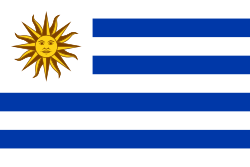This article needs additional citations for verification .(August 2019) |
 | |
| Drivers | 4 |
|---|---|
| Grands Prix | 6 |
| Entries | 7 |
| Starts | 6 |
| Best season finish | NC |
| Wins | 0 |
| Podiums | 0 |
| Pole positions | 0 |
| Fastest laps | 0 |
| Points | 0 |
| First entry | 1952 British Grand Prix |
| Latest entry | 1959 French Grand Prix |
| 2025 drivers | None |
There have been 4 Formula One drivers from Uruguay . [1]